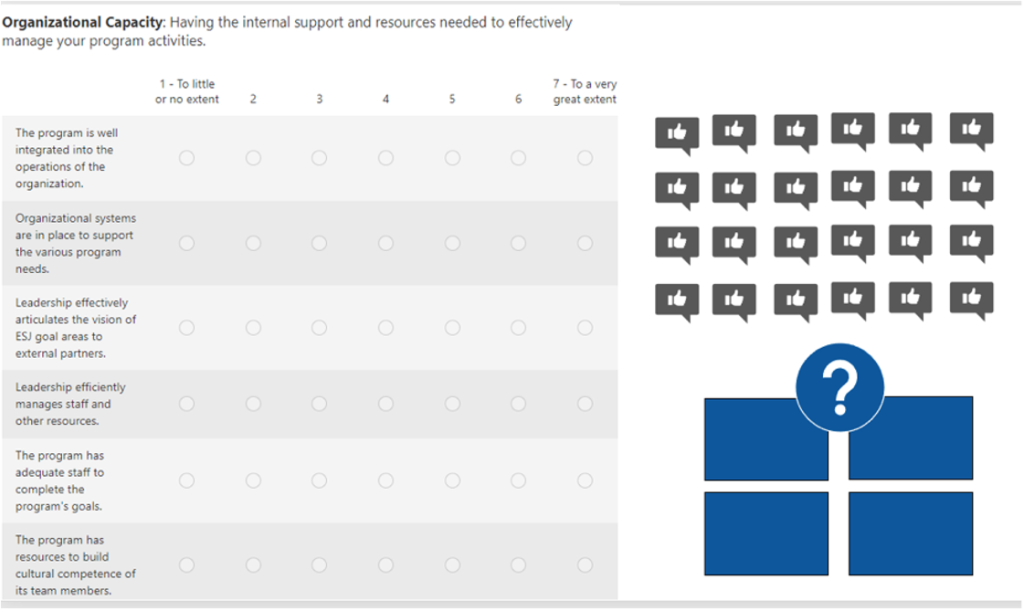Hello, AEA365 community! Liz DiLuzio here, Lead Curator of the blog. This week is Individuals Week, which means we take a break from our themed weeks and spotlight the Hot Tips, Cool Tricks, Rad Resources and Lessons Learned from any evaluator interested in sharing. Would you like to contribute to future individuals weeks? Email me at AEA365@eval.org with an idea or a draft and we will make it happen.
Hello network! My name is Dr. Tatiana Elisa Bustos—a community psychologist and evaluator in the public sector. I’m here to share tips on participatory techniques for sustainability assessments of community initiatives.
What is Sustainability?
Sustainability refers to creating and supporting the structures and processes that allow a program, practice, or initiative to be maintained in a system or organization. We published a prior systematic review that examined sustainability strategies of public health interventions and found that sustainability of public health interventions is challenging because there is limited dedication to systematic assessments that build sustainability into early implementation. We also found that sustainability is a buzz word rather than a conceptually clear construct, knowing that this construct can vary by audiences and settings. Since then, I’ve seen studies on sustainability grow rapidly. I’m hoping to ignite this discussion for us to share additional tips on how we’re assessing sustainability to maintain the success of community initiatives in our evaluations.
How can I get started?
Hot Tip 1: Build on evidence informed tools that have examined sustainability
Many useful and systematic tools already exist that have done extensive reviews on what factors impact sustainment and can be used in planning. Some might be more useful in community or clinical care settings; some may be a good starting point for a framework on how to understand key components relevant to program sustainability. Here are the tools I recommend:
- Program Sustainability Assessment Tool (PSAT)
- Long Term Success Tool
- NHS Sustainability Model
- Sustainment Measurement Scale
Hot Tip 2: After selecting a tool, tailor to your contexts, attending to sociopolitical, community and organizational contexts
As an example, in using the PSAT, I’ve tailored the survey items by asking key partners what was missing in the domain areas (i.e., should we add additional items to “partnerships”). For the PSAT, adapting items is viewed as a best practice to capture a more responsive and relevant understanding of processes and outcomes. This has also been done across other settings, including schools and pediatric care settings.
Hot Tip 3: Plan for and assess early in creative ways

Building on our systematic review, we should always plan for sustainability as early as implementation. It is so important that we continue to sustain community initiatives beyond funding and ensure that we have other structures in place for longer term capacities. Beginning with an initial baseline to understand what sources of support are already in place can be beneficial in strategic planning for future program implementation activities. I also encourage us to think creatively for survey administrations—paper, interactive focus group session, electronic survey. Leave room for participants to comment to contextualize your understanding of responses. In the past, I’ve added open ended text boxes after each domain area to allow space for participants’ comments.
Hot Tip 4: Engage your key community and organizational partners
Understanding sustainability of programs or initiatives should be a collaborative effort. Understanding WHAT needs to be sustained can be understood from multiple perspectives of direct service providers. Understanding WHY something needs to be sustained can be enhanced in conversations with community partners. Embedding participatory techniques that prioritize transparency and collaboration are key. Always share initial findings back to key partners for sense-making of the results. In the past, I’ve applied interactive activities, such as sharing back results in jam board or mural board to engage key partners in discussions about what appears as missing, what they strongly agree with, and if anything surprises them.
If you have other tips on assessing program sustainability, please comment below!
Do you have questions, concerns, kudos, or content to extend this aea365 contribution? Please add them in the comments section for this post on the aea365 webpage so that we may enrich our community of practice. Would you like to submit an aea365 Tip? Please send a note of interest to aea365@eval.org . aea365 is sponsored by the American Evaluation Association and provides a Tip-a-Day by and for evaluators. The views and opinions expressed on the AEA365 blog are solely those of the original authors and other contributors. These views and opinions do not necessarily represent those of the American Evaluation Association, and/or any/all contributors to this site.
